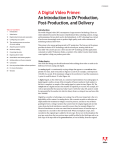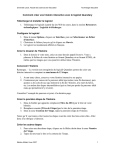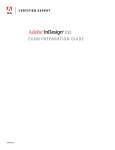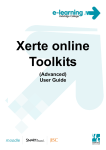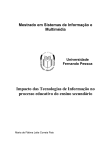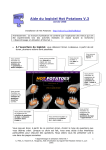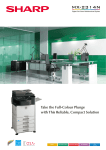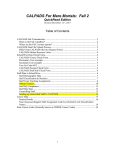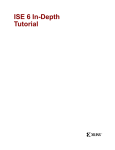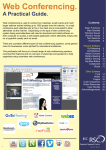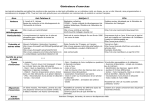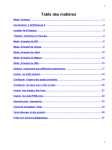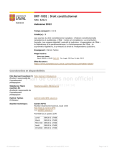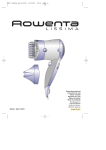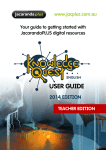Download NLN MATERIALS OFFENDERS
Transcript
NLNMaterials cover 7/10/09 14:58 Page 1 E-Enabling Offender Learning and Skills xxxxx NLN materials and offender learning NLN materials and offender learning E-Enabling Offender Learning and Skills NLN materials and offender learning Khawar Iqbal e E-Enabling Offender Learning and Skills NLN materials and offender learning Khawar Iqbal Copyright © 2009 National Institute of Adult Continuing Education (England and Wales) 21 De Montfort Street Leicester LE1 7GE Company registration no. 2603322 Charity registration no. 1002775 All rights reserved. No reproduction, copy or transmission of this publication may be made without the written permission of the publishers, save in accordance with the provisions of the Copyright, Designs and Patents Acts 1988, or under the terms of any licence permitting copying issued by the Copyright Licensing Agency. NIACE has a broad remit to promote lifelong learning opportunities for adults. NIACE works to develop increased participation in education and training, particularly for those who do not have easy access because of class, gender, age, race, language and culture, learning difficulties or disabilities, or insufficient financial resources. You can find NIACE online at www.niace.org.uk Typeset by Book Production Services, London Contents Introduction / 5 NLN materials / 6 NLN materials organisation / 6 What are NLN materials? / 6 Topics and levels / 6 Pedagogy / 8 What is contained in the OLAS pack / 10 Leisure / 10 Preparation for work / 12 Skills for Life and Key Skills / 14 Advanced Study / 15 Where to obtain the disks / 16 Using NLN / 18 Accessing the materials online / 18 How to get your logging in details / 18 How to register / 18 What is available on the website and where to find it / 18 Making collections and CDs / 21 Common problems / 21 Copyright / 22 Creating your own materials / 24 Integrating NLN into own materials / 24 Capturing images from NLN screens / 24 Capturing audio from NLN materials / 24 Integrating into your own resources / 25 Copyright and third party rights / 25 Create your own materials / 25 Hot potatoes /25 eXe / 26 Xerte / 27 Reload / 29 3 iv C O N T E N T S Further information / 30 NIACE / 30 Xtensis / 30 Regional Support Co-ordinators / 30 E-Guides / 31 What else is there? / 32 Discussion Forums – community of practice / 32 Useful websites / 32 Introduction This guide is available as a PDF download only and it may be printed for reference. The guide explains what the NLN materials are and how they can be used in both ICT and non-ICT related delivery. It also includes a section (section 3) which covers creating your own materials using other software. Each of the prisons in England has been sent a boxed set of the offender learning and skills NLN materials CDs. These CDs can be copied and used in accordance with the copyright notice; however, if you wish to obtain further boxed sets please contact [email protected]. 5 NLN materials NLN materials organisation What are NLN materials? The NLN materials are electronic learning objects that were produced as part of the National Learning Network, which was a Learning and Skills Council (LSC) funded national partnership programme designed to increase the use of Information Learning Technologies in teaching and learning across the adult education sector in England. Since 1999 Government funding totalling £156 million has led to the production of nearly 1,000 hours of e-learning materials and support services across a whole range of curriculum areas. The materials were created by a number of commercial developers, in partnership with subject matter experts from the education sector. Topics and levels There were four rounds of development. Rounds 1 to 3 covered vocational subjects at Levels 1–3 and some at advanced level. Round 4 was aimed at the community and voluntary sector. The following are the subject headings and levels: Round 1 Amenity horticulture Art and design levels Business studies levels Floristry General basic education Generic science Hospitality and catering Health studies Level 2 Levels 1 and 2 Levels 1 and 2 Level 2 Level 1 Level 1 Level 2 Levels 1–3 6 NLN MATERIALS AND Hair and beauty Key skills Mathematics Wider key skills OFFENDER LEARNING Level 2 Levels 1–3 Level 2 Levels 1–3 Round 2 Care, childcare and social care Construction crafts Engineering Environmental conservation Health and safety Maths for engineering and computing Performing arts Sport and recreation Travel and tourism Levels 2 and 3 Level 2 Level 2 Level 3 Level 2 Levels 1–3 Levels 1–3 Levels 2 and 3 Levels 1–3 Round 3 Basic skills: Literacy Basic skills: Numeracy Biology with sports science Catering Construction English General art and design Geography Hair and beauty History Key skills Maths Office administration Physics Psychology Sociology Level 1 Level 1 and entry level 3 Levels 2 and 3 Levels 3 and 4 Levels 2 and 3 Level 3 (AS/A2) Levels 1–4 Level 3 (AS/A2) Levels 2 and 3 Level 3 (AS/A2) Level 3 Level 3 (AS/A2) Levels 1 and 2 Level 3 (AS/A2) Level 3 (AS/A2) Level 3 7 8 NLN MATERIALS AND OFFENDER LEARNING Round 4 English for speakers of other languages (ESOL) Entry levels 1 to 3, Levels 1 and 2 Family learning with pre-school children Level 2 Family learning with school age children Level 2 Making learning work for you Entry levels 1 to 3, Levels 1 and 2 Modern foreign languages (generic support) Levels 1 and 2 Pedagogy The NLN materials are small, flexible ‘bite-sized’ episodes of learning of about 20–30 minutes each; they are not complete courses. Each title is broken down into a number of sub topics, with each sub topic covering just one or two learning objectives. Each sub topic is broken down into a number of screens that the learner works through. The materials use a range of approaches aimed at engaging the learners in a variety of ways. They contain information, questions, practice exercises, quizzes, games and much more. They are designed to be fun and interesting and allow the learners to work at their own pace, gain knowledge, practice and engage the learner. They are designed to appeal to different learning styles and have plenty of built-in help as well as support for special needs. The following criteria were specified for the design of the materials: • The learning objectives should be clearly stated for the benefit of tutors and for independent learners within both the material and the tutor documentation. • The content should take the learner from the known to the new learning in appropriately sized stages. • The content should follow a clear strategy to achieve learning but need not be linear in design; a didactic approach to learning and the development of electronic page turning should be avoided. • The content should help the learner to reflect on, review and digest NLN • • • • • • • • • • • MATERIALS AND OFFENDER LEARNING 9 new learning and not just regurgitate facts. The content should test performance to see if learning objectives have been met. This should not be limited to multiple choice questions and similar devices but should comprise a range of techniques. The material should motivate the learner. The design should stimulate responses from the learner. The content should demonstrate how new knowledge and skills can be applied to real problems and situations. The materials should include activities for the learner and keep the learner involved – they should generate a desire in the user to learn and to continue to completion. The materials should provide a variety of strategies to accommodate different preferences in learning style. The language should be appropriate for the target audience. The materials should provide useful and supportive feedback based on the learners’ responses. Media (e.g. video clips, sound files, animations) should be appropriate to the learning objectives and not be used gratuitously. The materials should provide appropriate help facilities for the learner. The content should be accurate, valid, up-to-date and without errors. In class, materials may be used: • to demonstrate concepts visually that can be difficult or expensive to teach in other ways; • to facilitate small-group work using case-study or problem-solving exercises; • for individual study; and • as preparation for a class. For individual study, materials may be used: • as preparation for a class; • as a refresher or to help students catch up; and • as a revision tool. 10 N L N MATERIALS AND OFFENDER LEARNING What is contained in the OLAS pack The LSC have commissioned the selection and production of four packs of CDs (a total of 22 CDs) to contain a number of the learning objects from the various rounds of NLN materials which may be of particular value for offender learning. These CDs have been packaged specifically for offender learning and have gone through a process of selection based on appropriateness of the content for offender learning. However, it is worth noting that content should be viewed by tutors first to check for appropriateness for their particular target group as circumstances vary between institutions and target groups. The four CD packs have been compiled as follows: • • • • Leisure Preparation for Work Skills for Life and Key Skills Advanced Study Package 1 – Leisure This package contains 5 CDs as follows. CD1 Health and Fitness (total 60 learning objects) Health and fitness (17 learning objects) Breathing (6 learning objects) Fitness (6 learning objects) Muscles (6 learning objects) Nervous system (5 learning objects) Training (5 learning objects) Skeletal system (2 learning objects) The heart and circulatory system (3 learning objects) Sports science – the heart and circulatory system (3 learning objects) Quizzes (2 learning objects) Energy (5 learning objects) NLN MATERIALS AND OFFENDER LEARNING CD2 Art and Photography (total 45 learning objects) Techniques (7 learning objects) Health and safety (3 learning objects)) Drawing and painting (20 learning objects)) Other techniques (5 learning objects)) Presenting and evaluating work (2 learning objects) Photography (8 learning objects) CD3 Performing Arts, Music and Theatre (total 51 learning objects) Health and safety awareness (3 learning objects) Lighting system (5 learning objects) Lighting design (8 learning objects) Stage management (8 learning objects) Quizzes (6 learning objects) Stage lighting (3 learning objects) Stage makeup (2 learning objects) Theatre design (4 learning objects) Music technology (12 learning objects) CD4 Modern Foreign Languages (total 34 learning objects) Language learning (6 learning objects) Nouns and articles (3 learning objects) Adjectives (3 learning objects) To be, to have, impersonal verbs (2 learning objects) Tenses (13 learning objects) Prepositions 2 learning objects) Pronouns (5 learning objects) CD5 Family Learning (total 65 learning objects) Pre-school 1. The growing child (7 learning objects) 2. Learning and playing (9 learning objects) 3. Out and about (7 learning objects) 4. Pre-school – family life (6 learning objects) School age (7–11) 5. Attitudes and approaches (5 learning objects) 11 12 N L N MATERIALS AND OFFENDER LEARNING 6. Family, friends and relationships (7 learning objects) 7. School (5 learning objects) 8. Creativity and games (7 learning objects) 9. Parenting (4 learning objects) 10. Feelings, worries and problems (8 learning objects) Package 2 – Preparation for Work This package contains 5 CDs as follows: CD1 Hotel and Catering (total 99 learning objects) Hospitality (5 learning objects) Health and safety (10 learning objects) Equipment (5 learning objects) Cooking (1 learning objects) Fish (11 learning objects) Cooking fish (17 learning objects) Cooking chicken (7 learning objects) Menu planning (9 learning objects) Food safety (8 learning objects) Kitchen organisation (4 learning objects) Sales and customer relations (9 learning objects) Getting a job (13 learning objects) CD2 Gardening and Floristry (total 86 learning objects) Gardening Garden principles and design (10 learning objects) Garden maintenance (7 learning objects) Planting (8 learning objects) Hedges, trees and lawn (4 learning objects) Pruning (5 learning objects) Weeds (6 learning objects) Floristry Design (12 learning objects) Equipment (7 learning objects) Health and safety (4 learning objects) NLN MATERIALS AND OFFENDER LEARNING Floral arrangements (10 learning objects) Getting a job (13 learning objects) CD3 Hairdressing and Beauty Therapy (total 51 learning objects) Hair (6 learning objects) Shampooing (2 learning objects) Perming (7 learning objects) Beauty treatments (9 learning objects) The salon (6 learning objects) Skin (4 learning objects) Anatomy (4 learning objects) Getting a job (13 learning objects) CD4 Building, Construction and Household Electrics (total 84 learning objects) Household electrics (16 learning objects) Health and safety (12 learning objects) Bricks (8 learning objects) Building materials (4 learning objects) Construction work (7 learning objects) Design and planning (10 learning objects) Utilities (1 learning object) Calculations (8 learning objects) Tenders and contracts (5 learning objects) Getting a job (13 learning objects) CD5 Office and Admin (total 113 learning objects) Business and finance (7 learning objects) Office administration skills (8 learning objects) Office equipment (11 learning objects) Games and quizzes (11 learning objects) General (3 learning objects) Business studies (21 learning objects) Office skills (18 learning objects) Employee rights and responsibilities (3 learning objects) Management (8 learning objects) Case studies (4 learning objects) 13 14 N L N MATERIALS AND OFFENDER LEARNING Health and safety (6 learning objects) Getting a job (13 learning objects) Package 3 – Skills for Life and Key Skills This package contains 6 CDs as follows: CD1 Study Skills 1 (total 35 learning objects) Learning to learn (6 learning objects) Extending your learning (14 learning objects) Managing your learning (15 learning objects) CD2 Study Skills 2 (total 42 learning objects) Practical skills (21 learning objects) Motivational learning (21 learning objects) CD3 Numeracy and Application of number (total 92 learning objects) Numeracy Understanding decimals (4 learning objects) Tally charts (2 learning objects) Adding and subtracting money (3 learning objects) Fractions and percentages (8 learning objects) Dealing with numbers (8 learning objects) Time (4 learning objects) Quantities (6 learning objects) Area, perimeter and volume (3 learning objects) Handling data (11 learning objects) Theme based (11 learning objects) Financial literacy (8 learning objects) Application of number Areas and volume (2 learning objects) Decimals and percentages (3 learning objects) Estimating and rounding (4 learning objects) Scales, ratios and proportions (9 learning objects) Data handling (3 learning objects) Themes (3 learning objects) NLN MATERIALS AND OFFENDER LEARNING CD4 Literacy and Communication (total 116 learning objects) Literacy Reading (32 learning objects) Speaking and listening (2 learning objects) Writing (26 learning objects) Themes (9 learning objects) Communication Level 1 – practice (13 learning objects) Level 1 – tutorial (13 learning objects) Level 1 – assessment (12 learning objects) Level 2 – practice (3 learning objects) Level 2 – tutorial (3 learning objects) Level 2 – assessment (3 learning objects) CD5 ESOL 1 (total 72 learning objects) Entry level 1 (6 learning objects) Entry level 1 – practice materials (8 learning objects) Entry level 2 (19 learning objects) Entry level 2 – practice materials (9 learning objects) Entry level 3 (19 learning objects) Entry level 3 – practice materials (11 learning objects) CD6 ESOL 2 (total 52 learning objects) Level 1 (17 learning objects) Level 1 – practice materials (9 learning objects) Level 2 (17 learning objects) Level 2 – practice exercises (9 learning objects) Package 4 – Advanced Study This package contains 6 CDs as follows: CD1 Application of number (total 17 learning objects) Co-ordinate geometry (4 learning objects) Differentiation (4 learning objects) Integration (6 learning objects) Exam preparation (3 learning objects) 15 16 N L N MATERIALS AND OFFENDER LEARNING CD2 Communication and IT (total 16 learning objects) Communication (8 learning objects) Information technology (8 learning objects) CD3 English Language (total 17 learning objects) Language and ideology (3 learning objects) Language change and identity (4 learning objects) Spoken language (3 learning objects) Systematic frameworks for analysis (7 learning objects) CD4 Geography (total 25 learning objects) Altai-Sayan (2 learning objects) Anticyclone (2 learning objects) Sea levels (6 learning objects) Coastal areas (3 learning objects) Management (4 learning objects) General topics (8 learning objects) CD5 History (total 32 learning objects) Origins of WW1 (2 learning objects) Ireland (2 learning objects) Germany (18 learning objects) Russia (10 learning objects) CD6 Sociology (total 28 learning objects) Research methods (5 learning objects) Social change (10 learning objects) Sociological theory (7 learning objects) The family (6 learning objects) Where to obtain the disks One set of CDs was sent to each offender learning institution in England in February 2007. Information of who this was sent to and requests for replacement copies (if available) can be made to [email protected]. It was the intention that each institution would have one set of disks which can be readily copied as long as the NLN MATERIALS AND OFFENDER LEARNING 17 copies are used under the same copyright rules as the original disks (see Using NLN/Copyright). Alternatively, collections can be made of learning objects from the NLN website and burned onto a CD, or used online if the learners have access to the Internet. Further details of how to do this are available in Using NLN/Making collections and CDs. Using NLN Accessing the materials online How to get your logging in details The NLN materials are hosted by Xtensis on the website www.nln.ac.uk. All four rounds of materials are available to access online, to burn onto CDs or to host in a number of other ways. You can see the range of materials available on the website without registering. However, to use the materials you have to register and to do this you need to have an email address and an organisation password. The latter can be obtained from anyone within your institution who is already registered. New users need to individually register to use the NLN materials. All organisations are listed and registration is available to post-16 practitioners. If an organisation is not listed please e-mail [email protected]. How to register You can register by selecting ‘new user’ in the log-in box at the top left of the screen. Thereafter, follow the screens, first selecting the sector you belong to, ‘Offender Learning and Probation,’ then the region you are based in, followed by the organisation. You will then be prompted to enter the password for your organisation which will allow you to enter your name, your e-mail address as your username and a password of your choice. Full registration and user instructions are available by selecting ‘User Guide’ under the ‘Support’ button on the home page. Note that you do not need to be registered in order to access the User Guide. What is available on the website and where to find it The materials are available from the home page under the heading ‘Materials’. Below this heading are four titles: 18 NLN • • • • MATERIALS AND OFFENDER LEARNING 19 ACL Basic/Core/Key Skills Subjects Vocational To the right of these headings are down arrows. Click on the arrow to see a list of categories with the levels available. Click on any of the squares labelled E3, E2, L1 etc depending on which level you are interested in. You will then see a list of the learning objects. You can select any one of them to view or to add to a collection. (For more information on collections see Making collections and CDs). Also on the home page are buttons marked ‘Background and Pedagogy’ and ‘Support’. Selecting these will give you a list of options. Below is a very brief summary of what is included under each option: Background and Pedagogy: News: History: Future: About the materials: Using the materials: Pedagogy: Cross-curricula mappings: Lesson plans/schemes of work: Case studies: Current news items related to the materials Background to the NLN materials Plans for rolling out to different sectors How and when to use the materials and some general information Links to publications and videos on how the materials have been and could be used The teaching theory behind the construction of the materials and how to use them in the classroom Mappings to courses and qualifications Some example lesson plans and schemes of work Five case studies of how the materials are being used in colleges 20 N L N MATERIALS AND OFFENDER LEARNING Support: FAQ: User guide: Terms of use: Plug-ins: Using NLN materials in Moodle: Tutor documentation: Projects: Contacts: Frequently asked questions under the following headings: Functionality Transition User Accounts Known issues and requested features Issues with particular sets of learning Objects 27-page downloadable Microsoft Word user guide on using the materials repository Licensing, ownership rights and privacy policy information What you need on your computer to be able to run the materials successfully Information for those wanting to create a local repository on their local VLE, in particular Moodle Tutor guides on using many of the materials are accessible from here Brief description about the Offender Learning CDs, a DVD for a science learning project and embedding NLN materials in Moodle (Noodle) Contact details for the NLN helpdesk and the Regional Support Co-ordinators (RSCs) NLN MATERIALS AND OFFENDER LEARNING 21 Making collections and CDs As there are so many learning objects on the system it is quite easy to lose track of which titles you found useful for particular classes, for example. What you can do is create ‘collections’. These allow you to save learning objects of your choice in groups called collections; this is equivalent to saving files in named folders. To do this you first create a collection title by selecting ‘new title’ under ‘collections’ to the left of the screen. Once a collection title has been created you can browse the system and decide which learning objects you want to add to your collection. When you have the list of titles on your screen you can check the ones you want to use. Then select the collection you want to add these to in the collections box to the left of the screen. Full user instructions with screenshots are available online by selecting ‘User Guide’ under the ‘Support’ button. Common problems Sometimes nothing happens when you click on the screen. One cause of this might be that you have a pop-up blocker enabled. If possible add www.nln.ac.uk to the list of allowed sites. Check that the same sites are allowed on the computers that your learners are going to use. Changes in Microsoft Internet Explorer has meant that animations now have to be activated by clicking in the box where the animations appear. Before an animation is activated users may see a dotted border around the animation area. Having an old version of Internet Explorer can sometimes affect the way images appear and the non-responsiveness of interactions. There are other plug-ins you will need for various learning objects and here is a quick checklist: • • • • Adobe Flash Player Adobe Shockwave Player Quicktime Realplayer 22 N L N MATERIALS AND OFFENDER LEARNING Downloads are available from the ‘Plug-ins’ options under ‘Support’ on the NLN website; some are also available on the Offender Learning CD collections, or links provided in the booklets accompanying the CDs. Copyright Members of organisations delivering learning to offenders in the UK can have free access to the NLN materials under a licence agreement for which the full text is available the first time you register onto the Xtensis website. You can access the text of the licence at any time from www.nln.ac.uk/?p=License. The essence of the licence agreement is that you do not use the materials for profit. You can use them to generate income for services for which you normally receive funding (for example, LSC funding) as long as the materials are not used in a way which independently creates other sources of income. The licence covers the following organisations: • • • • UK Further Education and Sixth Form Colleges English LSC-funded Specialist Colleges English funded Adult & Community Learning English funded Work Based Learning providers including voluntary organisations • Offender institutions in England For details about use of the materials outside of England and the UK, visit www.nln.ac.uk and click on ‘Support’ as the materials are not freely available outside of the organisations listed above. Under the licence you can also disaggregate the materials so you can use parts of them in other materials provided that the NLN copyright and third party copyrights are not infringed, and also acknowledged in the resulting materials, and that you do not make a financial gain. Third party content is where the producers of the materials have obtained authorisation to include someone else’s work. That third party may have put restrictions on how their work can be used. NLN MATERIALS AND OFFENDER LEARNING 23 Details of this are available on www.nln.ac.uk/?p=ThirdParty. There is also a list available from this link that shows which learning objects contain such content and the restrictions placed upon their use. The above is an interpretation of just a few of the terms of the licence agreement by the authors of this article. You are strongly advised to read the full NLN materials licence agreement terms carefully, as you can only use the NLN materials if you agree to be bound by the NLN materials licence terms. Creating your own materials Integrating NLN into your own materials Capturing images from NLN screens If you come across some inspiring images that are not subject to third party rights (see What is available on the website and where to find it), that you want to reuse/repurpose, you can do so by capturing the screen image. When you have the appropriate window on your screen that contains the image, press Alt, and while holding this key down press PrintScrn on your keyboard. This will copy the image to the clipboard of your computer, basically holding it somewhere until you ‘paste’ it into another place. For example, when you are in a Word document or a PowerPoint slide, select ‘Edit’ followed by ‘Paste’ and your image will appear. The image can then be cropped and resized. In Microsoft Word, clicking on the image makes the Picture toolbar appear. If the toolbar is not visible, then check the Picture toolbar is selected by right clicking on the image and selecting ‘Show Picture Toolbar’. On the toolbar you have various icons which allow you to place the image amongst text, crop and resize. Capturing audio from NLN materials The simplest way to capture audio is by opening up the Sound Recorder (Start, Programs, Accessories, Sound Recorder). While the audio is playing, press the Record button on the sound recorder. Press ‘Stop’ when you have reached the end. Save the audio file. There are better ways of doing this as there are limitations with this method and the quality of the sound is not so good. You can use a free audio editor and recorder called Audacity, available from www.audacity.sourceforge.net. 24 NLN MATERIALS AND OFFENDER LEARNING 25 Integrating into your own resources There are a number of ways of creating interactive resources using features available in Microsoft Office. In Microsoft Word, for example, you can use Forms and Hyperlinks to create resources for learners. You can add images and audio from NLN materials to enhance the content of any resources you produce. Here are some e-books courtesy of RSC Northwest on how to use some of the features in Microsoft Office products to create your own resources: www.rsc-northwest.ac.uk/acl/BookCase/library.htm. You can also produce your own resources using Hot Potatoes (see Create your own materials), and enhance the exercises using audio and images from the NLN materials. Copyright and third party rights When copying NLN learning objects you are bound by the same copyright rules, on the same basis as those for the original materials. However, if you take elements to include into your own materials then you must remember that there may be third party rights on some assets within the materials. Any such material where third party restrictions apply are listed here. www.nln.ac.uk/?p=ThirdParty. Create your own materials Hot Potatoes Create your own interactive materials using Hot Potatoes. Hot Potatoes is a set of tools which allows you to create the following types of interactive activities: • JCloze – gap fill • JMatch – matching and ordering • JQuiz – multiple choice or short response 26 N L N MATERIALS AND OFFENDER LEARNING • JMix – jumbled sentences and words • JCross – crossword puzzles When creating these exercises you need to enter the text for the questions and options for possible answers, but you can also add pictures and audio. There may be parts of the NLN materials that inspire you, or you find particularly useful for your learners. You can take pictures, text and audio (see Integrating NLN into your own materials) and include them in the Hot Potatoes exercises. Hot Potatoes is provided by Half Baked Software and is free to download and free to use by educational institutions which are non-profit making, or individuals working for them, on the condition that the materials you produce using Hot Potatoes are freely available to others via the Internet. The following links may be useful: • Half Baked software website: www.halfbakedsoftware.com • Hot Potatoes home page: www.hotpot.uvic.ca • Download hot potatoes. Available from the hot potatoes website home page www.hotpot.uvic.ca • Hot Potatoes User Guide can be downloaded from: www.hotpot.uvic.ca/tutorials6.php • Hot Potatoes frequently asked questions: www.hotpot.uvic.ca/v6_faq.php eXe eXe is an e-learning editor (or content creation tool) that can be used to create web-based learning and teaching materials without the need to know HTML or to use web-publishing applications. Content created in eXe can be used in Virtual Learning Platforms or used as self-contained web sites. You can find out more about eXe from the Wikipedia page www.wikieducator.org, which contains information, hints, tips and an online tutorial. An eXe User Manual is available from the RSC Northwest website at www.rsc-northeast.ac.uk, or an e-book on eXe is accessible here at www.rsc-northwest.ac.uk/acl/bookcase, courtesy of RSC Northwest. NLN MATERIALS AND OFFENDER LEARNING 27 You can download the software from the eXe learning site (www.exelearning.org) where you’ll also find links to support forums. Xerte Developing high quality content with accessibility built in. The NLN materials offer excellent possibilities for offender learning but what if you want some resources that don’t exist? What if you want more accessible learning objects so your dyslexic learners can change colours or fonts and the poor readers can have text read out by the software? Alistair McNaught from the JISC TechDis service has been exploring a tool that can let you make your own high quality, highly accessible resources – and best of all it’s free and there’s a really simple version to get you going. It’s called Xerte. What is Xerte and who is behind it? Xerte (XML Editor and Run Time Engine) was developed by Julian Tenney from the University of Nottingham’s Learning Team. It was designed as a developer’s toolkit to create interactive learning objects that were highly accessible. The JISC TechDis service were impressed by the way accessibility had been considered from the outset and were keen to promote the use of the Xerte tool, particularly since Nottingham make it freely available via their open courseware initiative (U-Now). The difficulty was to reconcile the powerful potential of the Xerte tool with the high level of technical skill required to operate it in its original form. Xerte was written by a developer for developers but JISC TechDis and Nottingham recognised that there was a need for a tool that could also be used by teaching practitioners without technical expertise. TechDis worked with Julian Tenney and Ron Mitchell from Tower Hamlets College to explore the production of a simple wizard that would allow practitioners to swiftly develop highly accessible learning objects. What makes Xerte so good for learners? A range of content can be shovelled into Xerte including text, images, video clips and sound. Irrespective of the content put into Xerte, the finished learning object has the following accessibility benefits: 28 N L N • • • • • MATERIALS AND OFFENDER LEARNING Navigation framework is automatically created so users do not get lost. The navigation is entirely keyboard accessible. There are seven user-selectable colour schemes. The font (screen) size is user selectable. Text-to-speech is automatically enabled when the learning object is viewed through Internet Explorer browsers. In addition to these technical aspects of accessibility, the ease with which multimedia (in the appropriate format) can be added also adds to the learner’s experience, creating a different type of accessibility. With built-in text-to-speech (including navigation) learning objects created with Xerte can be navigated and voiced without a screen reader. It has additionally been tested with a Jaws user who identified some minor issues but described it as ‘one of the most accessible flash objects I have come across.’ Three different flavours of Xerte The novice: Using the TechDis template, these users can rapidly put together a presentational learning object. This can include text information, images and audio/video files in the appropriate format. It can also have hyperlinks to other websites or other Xerte learning objects, but it does not have self assessment or other interactivities. The adventurous novice: Using an additional template created by the University of Nottingham, it is possible to develop more complex and varied learning objects which include interactivities such as quizzes, dragand-drop labelling and interactive hotspots as well as in-page navigation structures (e.g. slideshows, tagged subsections to provide additional information). A demonstration file is available at www.nottingham.ac.uk/toolkits/modules/Xerte/training/toolkits.htm. The expert developer: Where content creators have a high level of experience in flash and/or action scripting, they can work outside of the template environment and create very sophisticated learning materials. NLN MATERIALS AND OFFENDER LEARNING 29 How do Xerte learning objects compare to NLN learning objects? Since accessibility was incorporated into the design of Xerte at the beginning, any learning object created with Xerte compares extremely well with the NLN learning objects. In terms of technical accessibility, Xerte objects exceed the majority of NLN materials. In terms of accessibility by learner engagement, the relative benefits depend on which flavour of Xerte the learning object was created with. The novice version is good on technical accessibility but creates learning objects that are less interactive than most NLN materials. The adventurous novice can, however, create learning objects that compare very favourably with some of the best NLN materials. Where do I find out more? The Xerte software can be downloaded from www.nottingham.ac.uk/xerte and there is also a link from the page to the TechDis template. Guidance on using the TechDis template and the Nottingham template is available from www.techdis.ac.uk/getxerte. Reload Reload is a content packager for learning objects produced as part of a JISC project. It allows units of learning content such as NLN materials, PowerPoint presentations, Hot Potatoes exercises, video clips and Word documents to be packaged together. The Reload editor can be downloaded free from www.reload.ac.uk. Here is a technical guide on how to use Reload with NLN materials. www.excellence.qia.org.uk/page.aspx?o=153371 This is intended to be used with version 1.3 released in July 2004. Further information NIACE NIACE was commissioned by the LSC to produce this publication. NIACE (the National Institute of Adult Continuing Education) is the national organisation for adult learning in England and Wales. NIACE has a broad remit to promote lifelong learning opportunities for adults. NIACE works to develop increased participation in education and training, particularly for those who do not have easy access because of class, gender, age, race, language and culture, learning difficulties or disabilities, or insufficient financial resources. For more information, visit www.niace.org.uk or contact [email protected]. Xtensis Xtensis Ltd is contracted by the LSC to host the NLN materials on the website www.nln.ac.uk. Managing Director: [email protected] Technical Director: [email protected] Support: [email protected] Regional Support Co-ordinators The JISC (Regional Support Co-ordinators, RSCs) work with learning providers in their regions to realise opportunities created by the development of new learning technologies. There are RSCs in 13 locations across the UK to support innovation in learning in their regions. RSCs provide support in the following areas: • Staff development • Teaching/learning • Learning resources 30 NLN MATERIALS AND OFFENDER LEARNING 31 • Learning platforms • Senior management strategies • Technical/networks/connectivity RSCs perform the following functions: • • • • • • • • • • Act as the regional first point of contact Support e-learning development Advise on e-learning staff development Exploit IT for learning Support infrastructure and systems Offer advice, support and guidance Build collaborative networks Act as liaison between learning providers and services Build regional partnerships Support regional and local strategy Contact details of the RSC centre for your region are available from: www.trainingprovider.com/RSC-Marketing-Flyer-04.pdf. E-Guides E-Guides is delivered on behalf of the Learning and Skills Improvement Service (LSIS) as part of the Teaching and Learning Programme (TLP). Since 2004, NIACE has managed the E-Guides Training Programme. The programme is an introduction for post-16 practitioners to e-learning and using technology effectively in teaching and learning. The E-Guides programme has made a major contribution to the ematurity of organisations in Personal Development and Community Learning (formerly known as ACL – Adult and Community Learning), Work-Based Learning, Voluntary and Community Sector and Offender Learning and Skills. The free, three-day E-Guides programme aims to increase the use of elearning through developing the skills and knowledge of ‘E-Guides’ so that they are able to support colleagues from all subjects in their use of technology in teaching and learning. 32 N L N MATERIALS AND OFFENDER LEARNING At the time of writing, 2,627 E-Guides have been trained across approximately 1,100 organisations. E-Guides are instrumental in bringing about a culture change to embrace ILT within their organisations. They act as champions and mentors in the field of ILT, having been exposed to a range of ILTs during their training. They are a great source of information, support and encouragement when you want to introduce NLN materials into your teaching and learning. If there are no E-Guides in your organisation you can visit www.niace.org.uk/campaigns-events/events/conferences-seminarstraining-courses to find out if there is an E-Guides training programme still available. What else is there? Discussion Forums – community of practice You can access the OLAS community of practice from the QIA Excellence gateway website: www.excellence.qia.org.uk. From the home page of this website select the ‘EG Community’ tab from the top of the screen. Select ‘User forums from this page’, and you will get a list of forum names in alphabetical order. Find the one called ‘OLAS’, a community set up for the Offender Learning and Skills sector. Here you can review useful resources, discuss ways of using resources, discuss common issues, and provide peer support for OLAS practitioners. Useful websites The ‘paving the way’ guidelines cover pedagogy, accessibility, technical standards and quality assurance as well as information and dissemination activities carried out by the NLN materials team. The guidelines can be accessed via the home page at www.nln.ac.uk by clicking on ‘Background and Pedagogy’ and following the ‘Using the materials’ link. The guidelines include a downloadable PDF document and set of videos.

































